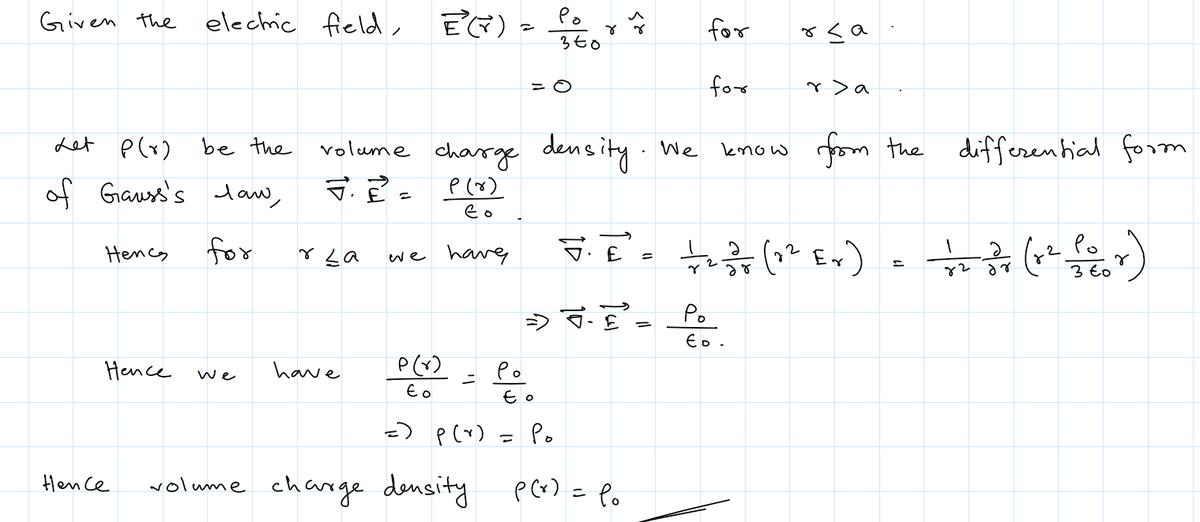hand write, more details, Step by step solutions Spherical Charge System with Zero External Field: What spherical charge distribution creates the field given at right, where r is defined as in spherical coordinates? Note the discontinuity in the field: what does this require at the surface? E(T) = Porsa 380 0 r>a
hand write, more details, Step by step solutions Spherical Charge System with Zero External Field: What spherical charge distribution creates the field given at right, where r is defined as in spherical coordinates? Note the discontinuity in the field: what does this require at the surface? E(T) = Porsa 380 0 r>a
Related questions
Question
As soon as possible, Handwrite, more details please
![**Spherical Charge System with Zero External Field:**
What spherical charge distribution creates the field given at right, where \( r \) is defined as in spherical coordinates? Note the discontinuity in the field: what does this require at the surface?
\[
\vec{E}(r) =
\begin{cases}
\frac{\rho_0}{3 \varepsilon_0} \hat{r} & r \le a \\
0 & r > a
\end{cases}
\]
In this scenario, we are examining a spherical charge system with no external field. The electric field \(\vec{E}(r)\) is different inside and outside the sphere:
- **For \( r \le a \):** The electric field vector \(\vec{E}(r)\) is given by \(\frac{\rho_0}{3 \varepsilon_0} \hat{r}\). Here, \(\rho_0\) is the charge density, \(\varepsilon_0\) is the permittivity of free space, and \(\hat{r}\) is the radial unit vector in spherical coordinates. This expression indicates a uniform electric field inside a sphere of radius \( a \).
- **For \( r > a \):** The electric field is zero, implying that the influence of the charge distribution does not extend beyond the surface of the sphere.
This system presents a discontinuity at the surface \( r = a \), which must be addressed to ensure physical consistency, possibly through boundary conditions or surface charge considerations.](/v2/_next/image?url=https%3A%2F%2Fcontent.bartleby.com%2Fqna-images%2Fquestion%2F584ffa08-94ad-4eb4-a87d-fd258db9f802%2F57cc1c6e-b171-4d0e-9ef5-db50a25db3b2%2Fu5cg5gq_processed.png&w=3840&q=75)
Transcribed Image Text:**Spherical Charge System with Zero External Field:**
What spherical charge distribution creates the field given at right, where \( r \) is defined as in spherical coordinates? Note the discontinuity in the field: what does this require at the surface?
\[
\vec{E}(r) =
\begin{cases}
\frac{\rho_0}{3 \varepsilon_0} \hat{r} & r \le a \\
0 & r > a
\end{cases}
\]
In this scenario, we are examining a spherical charge system with no external field. The electric field \(\vec{E}(r)\) is different inside and outside the sphere:
- **For \( r \le a \):** The electric field vector \(\vec{E}(r)\) is given by \(\frac{\rho_0}{3 \varepsilon_0} \hat{r}\). Here, \(\rho_0\) is the charge density, \(\varepsilon_0\) is the permittivity of free space, and \(\hat{r}\) is the radial unit vector in spherical coordinates. This expression indicates a uniform electric field inside a sphere of radius \( a \).
- **For \( r > a \):** The electric field is zero, implying that the influence of the charge distribution does not extend beyond the surface of the sphere.
This system presents a discontinuity at the surface \( r = a \), which must be addressed to ensure physical consistency, possibly through boundary conditions or surface charge considerations.
Expert Solution
Step 1

Trending now
This is a popular solution!
Step by step
Solved in 2 steps with 2 images
